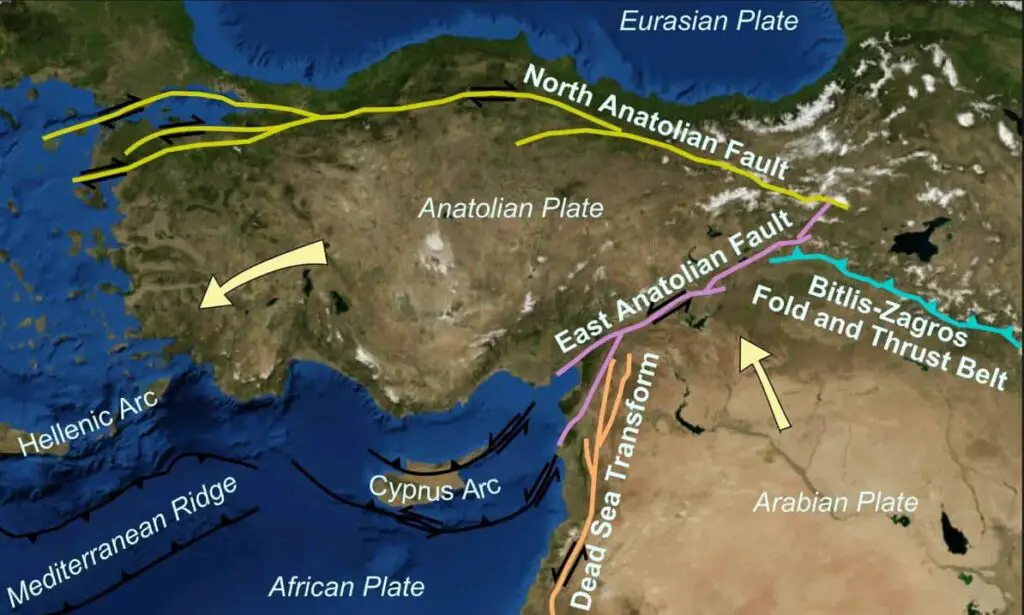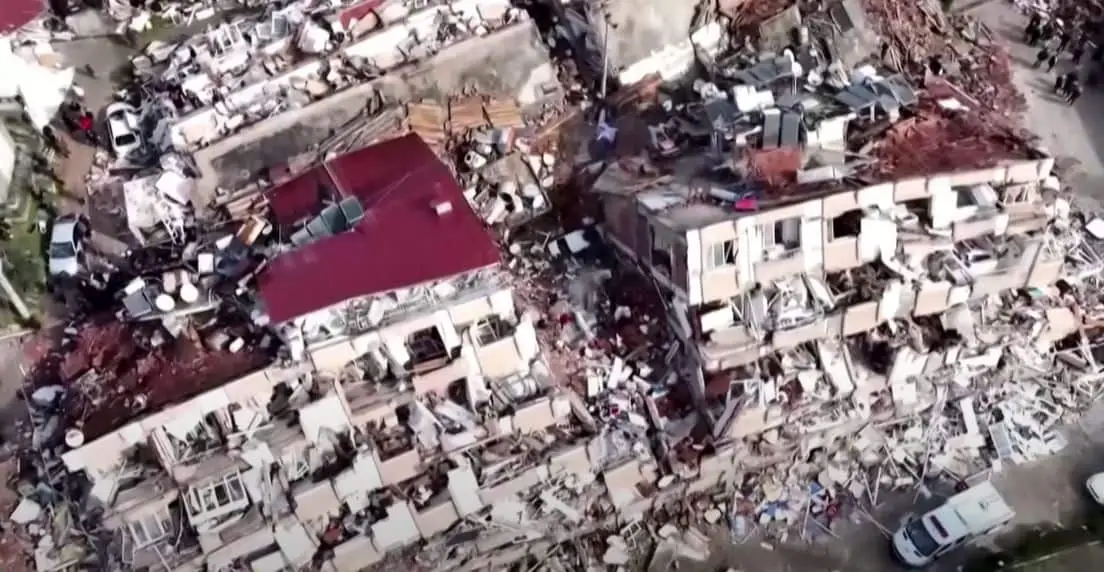The images of devastation which come from Turkey are appalling and raise the question of the causes of this catastrophe. Because if the first earthquake was powerful, it is not the only one responsible for the drama that is playing out at the moment.
For three days now, the inhabitants of southern Turkey and northern Syria have lived to the rhythm of the earthquakes.
The damage is considerable and the number of dead (12,200 deaths) continues to increase over the hours, despite the hard work of the rescuers. But what exactly happened to lead to such a catastrophe? As always, a number of factors have added up.
Table of Contents
Constructions that do not comply with earthquake-resistant standards
The first is of course the seismic risk to which the entire border region between Turkey and Syria is subject. The major East Anatolian fault, which runs for about 500 km, marks the boundary between two tectonic plates: the Arabian plate to the south, and the Anatolian plate to the north. This is sandwiched with the Eurasian plate.
The thrust generated by the Arabian plate therefore slowly slides the Anatolian block towards the west, along this large active fault, well known to seismologists. This so-called strike-slip fault is similar in its operation to the famous San Andreas fault in California. This type of fault can produce very powerful earthquakes because they are shallow, of the same order of intensity as those experienced by Japan, for example.

But, contrary to the latter case, the potential for destruction is much greater in Turkey. Japan is in fact at the forefront of technology with regard to seismic building standards, while Turkey, which nevertheless has the same level of seismic risk, devotes much less resources to it.
While Japanese buildings are capable of withstanding earthquakes of magnitude greater than 8, most constructions in Turkey are very fragile when faced with ground movements.
The 7.8 magnitude earthquake that occurred on Monday February 6, as well as the second one of barely lower magnitude (7.5) and the multiple aftershocks that followed therefore led to the collapse of a large number of buildings, trapping the inhabitants under the rubble. There were also several 6.0 + aftershocks which caused further disaster to damaged buildings.
The acceleration of the ground during the first shock must have reached 1 g, which is the equivalent of the acceleration of gravity. This is a very powerful vibration that can only be resisted by buildings that meet specific seismic standards.
Two major earthquakes a few hours apart
If the fragility of the building represents a primordial factor in this catastrophe, the sequence of events is a second. Because if an earthquake of magnitude greater than 7 was quite possible on this fault accumulating stress for several hundred years, to have a second one a few hours apart is unusual to say the least.
It is likely that the first earthquake destabilized another portion of the fault, leading to a sudden rupture of another segment, almost 100 km from the first epicentre.
According to Carlo Doglioni, geologist and professor at the University of Rome, the numerical models show that the ground could have moved laterally by about 3 meters in certain places! First approximation values which remain to be checked as soon as the satellite data are available.
Landslides and soil liquefaction
Given the power of the two earthquakes, many aftershocks, of magnitude 5 or more, are still to be expected in the coming days, until the fault has (locally) released all the accumulated tension.
Further destruction is therefore still to be feared. They could lead to new victims, the current very cold weather conditions pushing people to take shelter in weakened buildings.
“Many aftershocks, of magnitude 5 or more, are still to be expected in the coming days”
Other disastrous consequences of earthquakes: landslides. More and more images from Turkey show roads washed away by mountainside collapses, destabilized by vibrations. It is also possible that part of the destruction is linked to soil liquefaction, a phenomenon that occurs when certain types of soil are subjected to intense vibrations.
Fears of a destabilization of the North Anatolian fault
At present, it is still unclear whether this seismic crisis is over. It is possible, but nothing is to be excluded. Because the network of faults is important and complex in this region, as well as the tectonic constraints. It is possible that new fault segments will rupture in the near future as a result of the destabilization induced by the February 6 earthquakes.

The greatest fear of specialists is that the North Anatolian fault, on which Istanbul is located, will be affected. Istanbul is also the city where the seismic risk is the highest in the world, given the tectonic context, the number of inhabitants and the fragility of the buildings.
The earth never stops shaking in Turkey along this fault line
While the human toll continues to increase, aftershocks continue to follow one another in southwestern Turkey. A new earthquake, almost as powerful as the first, occurred at midday, continuing to sow chaos.
After the powerful 7.8 magnitude earthquake that shook the region on Monday morning, the earth continues to shake violently in Turkey and Syria. After dozens of new more or less violent tremors, it was a second earthquake of magnitude 7.5, almost as powerful as the first, which hit the Ekinozu region at midday.
While it is usual for smaller magnitude earthquakes to follow the main tremor in the hours or days that follow, having two events of such magnitude just a few hours apart is extremely rare. Especially since no earthquake of magnitude greater than 7 had yet been recorded on this East Anatolian fault.
“To have two events of such magnitude only a few hours apart is extremely rare”
In this case, it is difficult to speak of an aftershock. This is clearly a second seismic event, the epicenter of which is located about a hundred kilometers from the first. This earthquake should itself lead to a series of aftershocks, the magnitude of which could be around 6, and which could therefore cause further damage.
Why such an unleashing catastrophic earthquake happened ?
The country would not have experienced an earthquake of such high magnitude for 200 years. During this relatively long period of time, the tectonic stress associated with the thrust of the Arabian plate (see below) continued to accumulate, which certainly explains the power of the two events that occurred today.
Moreover, when a major earthquake occurs, it can destabilize other parts of the fault that were hitherto blocked and thus produce new tremors. We thus observe earthquakes in sequence and a “progression” of epicentres along the fault. That’s certainly what happened today.
This second earthquake brought down many buildings already weakened by the first earthquake. The human losses would exceed 20,000 dead. There would be nearly 100,000 injured.
Many organizations have already opened appeals for donations to help the victims.
What we know about the deadly 7.8 magnitude earthquake in Turkey and Syria
A violent earthquake of magnitude 7.8 took place this morning in the south-west of Turkey, on the Syrian border. The damage is very important and there are already some 1,472 dead both in Turkey and Syria and several thousand injured.
Turkey and Syria both live under the constant threat of violent earthquakes. A reality that is sadly remembered today by the inhabitants of the Mediterranean border region between the two countries.
It was before dawn that the earth shook violently on Monday, February 6. The epicenter is located north of the city of Gaziantep, in southwestern Turkey, near the Syrian border. Measuring 7.8, the earthquake was felt across the region, as well as in Lebanon, Israel, Jordan and Egypt. But it is in the epicentral zone that the situation is most dramatic.
Many buildings (11,800 listed) have indeed collapsed under the violence of the tremors and the multitude of aftershocks that followed, trapping the inhabitants who were still asleep. At the time these lines are written, the total toll would already be more than 8,912 dead in Turkey and 2,260 in Syria, it should unfortunately continue to increase.
Both countries quickly appealed for international assistance. Many countries have already offered to send relief. European rescue teams are already on the way. The situation in the affected Syrian region, held by rebels, is particularly critical due to the lack of doctors and medical means.




